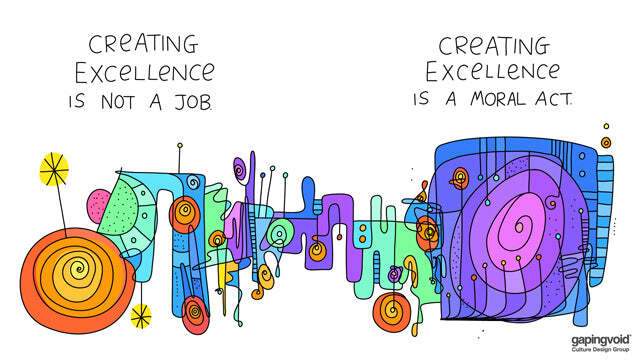How corporate culture, not just oil reserves, might determine the future of Big Oil
In the high-stakes world of energy mergers and acquisitions, numbers tell only half the story. When Chevron announced its $53 billion acquisition of Hess Corporation, analysts immediately focused on proven reserves, production capacity, and synergies. But buried beneath the spreadsheets and geological surveys lies a more intriguing narrative—one that could determine whether this mega-deal transforms Chevron into an industry powerhouse or becomes another cautionary tale of corporate integration gone wrong.
The story isn't just about oil. It's about people, culture, and the invisible forces that drive exceptional performance. And if recent stock performance data tells us anything, Chevron might be acquiring something far more valuable than Guyana's offshore reserves: a culture of execution that has consistently outperformed its own.
The Performance Gap That Nobody's Talking About
The numbers are stark and impossible to ignore. From 2022 to 2025, while Chevron's stock delivered a respectable but modest 29.8% return, Hess Corporation's shares soared an impressive 94.0%—more than tripling Chevron's performance during the same period. This isn't a statistical anomaly or a lucky streak. It's a systematic pattern that reveals something profound about how these two companies operate at their core.

Consider the trajectory: Hess started 2022 at 76.79 per share and climbed to 148.97 by 2025, while Chevron moved from 119.26 to 154.84. In absolute terms, Chevron's stock price increased by 35.58, while Hess gained 72.18—more than double the dollar appreciation despite starting from a lower base. This performance differential becomes even more remarkable when you consider that both companies operate in the same volatile energy sector, subject to identical commodity price swings, regulatory pressures, and market dynamics.
The normalized performance chart above dramatically illustrates the magnitude of this performance gap. When both companies are indexed to their starting values, Hess's superior execution becomes undeniable—a steady climb that reflects consistent operational excellence rather than market timing or luck.

But here's where the story gets interesting: this performance gap isn't just about financial engineering or lucky timing. It reflects something deeper—a fundamental difference in how these organizations approach challenges, execute strategies, and adapt to changing market conditions. In other words, it's about culture.
Culture as Competitive Advantage: The Invisible Driver of Returns
Corporate culture has long been dismissed as a "soft" metric, relegated to HR departments and employee satisfaction surveys. But mounting evidence suggests that culture might be the most powerful predictor of long-term financial performance. Companies with strong, execution-focused cultures don't just outperform their peers—they often outperform them by multiples.
The data supporting this thesis is compelling. Research consistently shows that organizations with highly engaged workforces and strong cultural foundations can achieve 2.3 times the revenue growth of their competitors, 1.4 times the earnings growth, and up to 12 times the stock performance over extended periods. When we examine Hess's 94% return against Chevron's 29.8%, we're not just seeing financial metrics—we're witnessing the tangible impact of cultural differences in action.
What makes Hess's performance even more remarkable is the context in which it was achieved. The energy sector faced unprecedented challenges during this period: supply chain disruptions, regulatory uncertainty, ESG pressures, and volatile commodity prices. Yet Hess not only navigated these headwinds but thrived, suggesting an organizational resilience and adaptability that goes beyond traditional operational metrics.
This resilience doesn't emerge from boardroom strategies or capital allocation decisions alone. It comes from thousands of daily decisions made by employees who are engaged, empowered, and aligned with organizational goals. It comes from a culture that rewards innovation, embraces calculated risk-taking, and maintains operational excellence even under pressure. In short, it comes from the very human elements that make organizations truly exceptional.
The Talent Exodus: Chevron's Potential Strategic Misstep
As integration plans unfold, Chevron has signaled its intention to implement significant workforce reductions among Hess employees. From a traditional cost-synergy perspective, this makes perfect sense. Eliminate redundancies, streamline operations, and capture the projected savings that justify the acquisition premium. It's the playbook that has guided countless mergers and acquisitions across industries.
But this conventional wisdom might be profoundly misguided when applied to the Chevron-Hess combination. If Hess's superior stock performance reflects superior execution capabilities—and the evidence strongly suggests it does—then the employees being targeted for elimination might represent the acquisition's most valuable assets. Chevron could be inadvertently letting go of the very people who created the performance differential that made Hess an attractive target in the first place.
Consider the implications: the engineers who optimized Hess's drilling operations and were empowered to innovate, the project managers who brought developments online ahead of schedule and under budget, the financial analysts who identified value-creating opportunities, and the operational teams who maintained safety and efficiency standards under challenging conditions. These individuals didn't just contribute to Hess's success—they were the architects of it.
The irony is profound. Chevron is paying a premium to acquire capabilities that Hess demonstrated through superior market performance, then potentially dismantling the human infrastructure that created those capabilities. It's like buying a championship sports team and immediately trading away the players who won the championship.
This approach reflects a fundamental misunderstanding of what drives sustainable competitive advantage in the modern energy sector. While technology and capital resources matter, they're increasingly commoditized. The real differentiator lies in execution—the ability to consistently make better decisions, implement strategies more effectively, and adapt more quickly to changing conditions. And execution is fundamentally a human capability, embedded in organizational culture and individual expertise.
The Broader Context: Big Oil's Performance Hierarchy
To fully appreciate the significance of Hess's performance, we need to examine it within the broader competitive landscape of major oil companies. Recent analysis of Shell, Exxon Mobil, and Chevron's stock performance from 2022 to 2025 reveals a clear hierarchy of execution and returns.
Exxon Mobil emerged as the sector leader with a 75.13% total return, transforming a 63.54 starting price to 111.28 by 2025. Shell followed with a strong 61.65% return, climbing from 44.64 to 72.16. Chevron, despite its size and resources, lagged significantly with its 30.25% return. This performance ranking isn't arbitrary—it reflects fundamental differences in how these organizations operate and execute their strategies.

The risk-adjusted performance metrics tell an even more compelling story. Exxon achieved a Sharpe ratio of 2.685, indicating exceptional returns relative to the risk taken. Shell posted a solid 2.333 Sharpe ratio, while Chevron managed only 1.076—less than half of Exxon's risk-adjusted performance. These numbers suggest that Chevron's challenges aren't just about market positioning or asset quality; they're about execution efficiency and risk management capabilities.

When we add Hess's 94% return to this analysis, the performance hierarchy becomes even more striking. Hess didn't just outperform Chevron—it outperformed the entire sector, including industry leaders like Exxon and Shell. This exceptional performance occurred despite Hess being significantly smaller than its peers, with fewer resources and less diversified operations. The only logical explanation is superior execution capabilities driven by organizational culture and human capital.
The Integration Challenge: Preserving What Made Hess Special
The central question facing Chevron's leadership isn't whether to integrate Hess—that decision has been made. The question is how to integrate Hess in a way that preserves and leverages the cultural and operational capabilities that drove its superior performance. This requires a fundamentally different approach than traditional merger integration.
Instead of imposing Chevron's systems and processes on Hess operations, Chevron should be studying what made Hess successful and selectively adopting those practices across its broader organization. This means identifying the decision-making processes, performance management systems, and cultural norms that enabled Hess to consistently outexecute its larger peers.
The opportunity extends beyond mere preservation to active enhancement. If Hess's culture and capabilities can be successfully integrated and scaled across Chevron's larger asset base, the combined entity could achieve performance levels that neither company could reach independently. This isn't just about adding Hess's production to Chevron's portfolio—it's about transforming Chevron's entire operational DNA.
Consider the potential impact: if Chevron could achieve even half of Hess's performance differential across its much larger asset base, the value creation would be enormous. A company that historically delivered 30% returns suddenly achieving 60-70% returns would fundamentally alter its competitive position and market valuation. The acquisition premium paid for Hess would look like a bargain in retrospect.
But realizing this potential requires recognizing that culture and human capital aren't just "nice to have" elements—they're the core drivers of sustainable competitive advantage. It requires treating the integration not as a cost-cutting exercise but as a capability-building opportunity. Most importantly, it requires humility from Chevron's leadership to acknowledge that the smaller company they acquired might have lessons to teach about execution excellence.
The Competitive Implications: Taking on Shell and Exxon
The stakes extend far beyond Chevron's internal transformation. The energy sector is entering a period of unprecedented change, driven by the energy transition, technological advancement, and evolving investor expectations. In this environment, the companies that will thrive are those that can execute most effectively, adapting quickly to new realities while maintaining operational excellence.
Exxon's recent performance demonstrates what's possible when execution capabilities align with strategic vision. The company's 75% return and 2.685 Sharpe ratio reflect not just favorable market conditions but superior decision-making and implementation. Shell's strong performance similarly indicates execution capabilities that Chevron has struggled to match.
But look at these percentages closely. Shell is not far behind Exxon on execution.

If Chevron can successfully integrate and scale Hess's execution capabilities, it could fundamentally alter this competitive dynamic. A Chevron enhanced by Hess's cultural DNA and operational excellence could challenge both Exxon and Shell for sector leadership. The company's larger asset base and financial resources, combined with Hess's execution capabilities, could create a formidable competitive force.
But this transformation isn't guaranteed. It requires deliberate effort to identify, preserve, and scale the human and cultural elements that drove Hess's success. It requires resisting the temptation to impose standardization at the expense of innovation. Most importantly, it requires recognizing that in an industry increasingly defined by execution excellence, the companies with the best people and strongest cultures will ultimately prevail.
Looking Forward: Questions That Will Define the Future
As this integration unfolds, several critical questions will determine whether Chevron realizes the full potential of its Hess acquisition:
- Will Chevron's leadership recognize that they're acquiring more than assets—that they're acquiring capabilities that could transform their entire organization?
- Can they resist the conventional wisdom of immediate cost-cutting in favor of a more strategic approach to integration?
- Will they have the humility to learn from a smaller company that consistently outperformed them?
- Perhaps most importantly, will they understand that in the modern energy sector, culture isn't just about employee satisfaction—it's about competitive advantage, operational excellence, and ultimately, shareholder returns?
The answers to these questions will determine not just the success of the Chevron-Hess acquisition, but potentially the future competitive landscape of the entire energy sector. In an industry where execution excellence increasingly separates winners from losers, the companies that best understand and leverage the human elements of performance will ultimately prevail.
The data is clear: Hess outperformed Chevron by more than 3:1 over the past three years. The question now is whether Chevron will preserve and scale the capabilities that created this performance differential, or whether it'll inadvertently discard its acquisition's greatest asset in pursuit of conventional synergies.
The clock is ticking, and the stakes couldn't be higher.
Want good returns? Contact us to learn more about ALLI.
This analysis is based on stock performance data from 2022-2025 and publicly available information about the Chevron-Hess acquisition.



.jpg)